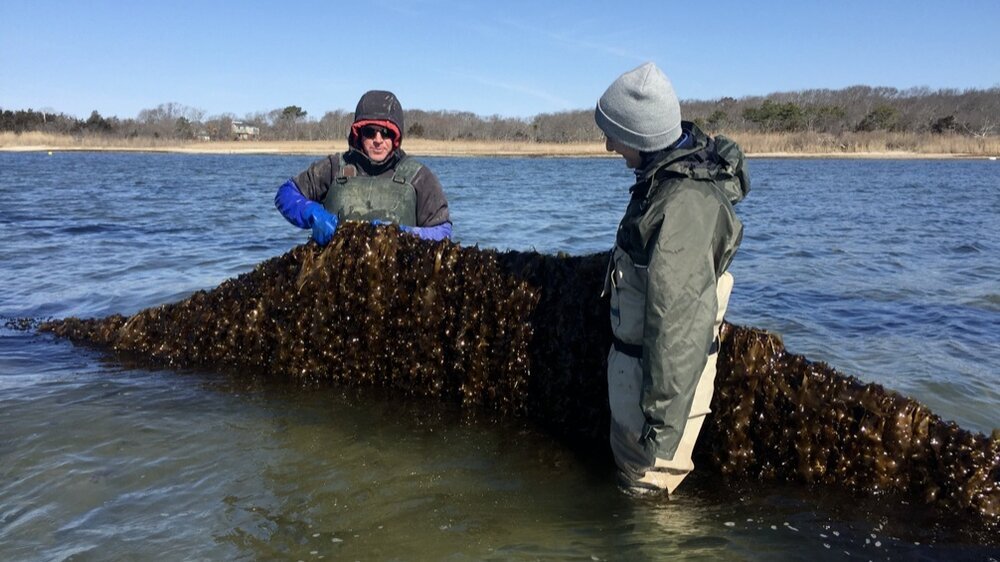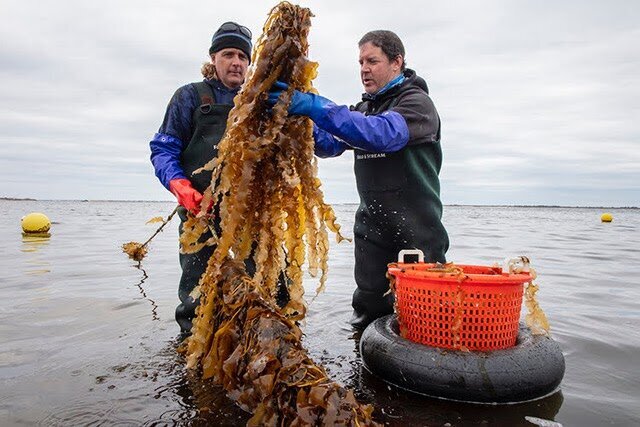Oyster Farmers in New York Grow Sugar Kelp in Just a Few Feet of Water
The majority of commercial kelp farms in the U.S. use growlines suspended several feet below the surface of the water by a system of anchors and buoys. But Mike Doall, the Associate Director for Bivalve Restoration at Stony Brook University, was curious to test whether kelp might grow just as well in Long Island’s shallow-water estuaries. A life-long Long Islander and retired oyster farmer himself, Doall couldn’t pass up the opportunity to experiment with kelp on his home turf. “When I found out kelp grew in the winter, I knew it would be a perfect companion crop for oysters,” he said.
In 2018, Doall, his colleague Dr. Chris Goebler at Stony Brook University, and GreenWave were awarded a grant from the New York Farm Viability Institute to test the feasibility of farming kelp in Long Island’s shallow water estuaries. For the past two and a half years, he has been working with eight oyster farmers across Long Island to incorporate sugar kelp into their shallow-water oyster sites, some with as little as 12 to 18 inches of water at low tide.
Paul McCormick, the owner of Great Gun Shellfish in Moriches Bay, was eager to participate in Doall’s trial. “There were so many naysayers,” said McCormick. “So many people who said it couldn’t be done, but we persevered. It was a great thing to discover we could grow kelp with 12-foot blades in a foot of water. It’s been a really rewarding experience.”
The setup that Doall and his partners developed uses a staked, rather than floating, system that holds the kelp growline just off the bottom. The entire system can be accessed by foot at low tide. Wearing chest waders, they screwed four-foot long helical anchors into the firm sandy bottom, leaving one foot of the metal rod protruding from the sand. They then stretched 110 feet of seeded growline between the two anchors, cinched the growline tight, and walked away. The results surprised everyone.
Diagram of the shallow-water system at Mean Low Water
Diagram of the shallow-water system at Mean High Water
“It turned out that the kelp grew really, really well,” said Doall. At some sites, the blades reached over 12 feet in length, with up to nine pounds per foot of growline—higher than many seasoned suspended system farmers might expect.
GreenWave typically recommends that new farmers look for sites with between 25 to 40 feet of depth at Mean Low Water. This allows enough vertical space to give farmers the option to incorporate hanging gear, such as lantern nets to house shellfish, as well as keep their kelp off-bottom to avoid biofouling. But at the farms on Long Island, kelp was staked just a foot off the bottom.
The concerns around biofouling turned out to be much less of a problem than anyone had predicted. “The kelp is all over the bottom,” said Doall, “but biofouling wasn’t an issue.” Doall and partners found that the kelp they outplanted earlier in the winter months was able to outcompete most fouling organisms, including slip gut, a ubiquitous brown slime. Doall said they observed many crabs living among the kelp on the sandy bottom, but there was minimal damage from grazers during the winter when these critters were less active.
As the water started to warm to around 10-13 degrees C (50-55 degrees F) they started to see more biofouling on the blades as well as blade senescence, where the tips of the kelp blades began to deteriorate. This indicated it was time to harvest.
Water temperature seemed to play a significant role in the timing of when biofouling began, and when kelp reached its peak biomass. At some sites that was mid-April, others late May. Doall sees this as a potential limitation for the industry on Long Island in the future as water temperatures continue to rise due to climate change. “How long the bays stay cold will determine the future of farming here,” he said.
One of the most enticing parts of Doall’s configuration for farmers is how inexpensive it is to source and install. “I’m embarrassed to call it an innovation just because it’s so simple,” he said. The two screw anchors, growline, and attachment hardware cost only $60-88 per line. Compared to the anchor costs at a traditional, deeper water site, which can often be several hundred dollars—in addition to the accompanying hardware and anchor lines—this minimalist system could offer new farmers a much lower barrier to entry.
The oyster farmers Doall partnered with have also found the system easy to work with and incorporate into their existing farms. “Everything is so much easier in shallow water,” said Paul McCormick, “It’s not anything like working on a boat. By a magnitude of 10-15, labor is reduced.” Last spring, McCormick and his crew harvested their kelp using floating baskets supported by innertubes that they towed behind them as they waded through knee-high water, removing kelp from the lines. “This is the ultimate low-tech, analog system,” he said.
There are some downsides. Mainly, the winter sea ice has proven to be the biggest challenge. This past winter, the sea ice in the Great South Bay destroyed several lines of kelp. Doall said that removing the buoys from the system helped mitigate the issue, but certain sites still experienced significant damage. In some cases, they added a bent piece of rebar at the midspan of the growline to try and pin the kelp down. McCormick warns that new farmers should study the ice formation patterns in their region. “If you’re in an area that freezes over thick in the winter, it could be a big challenge,” he said.
Because the growlines can be accessed by foot, it’s possible to site them much closer together, as there is no need to leave space for maneuvering a boat between the lines. The downside is that the staked lines hold the kelp at a fixed depth, so it’s not possible to pull them into a skiff or work from a boat at high tide. McCormick thinks the manual labor the system requires could potentially become a limitation for scaling. “But we’re not anywhere near that point, yet,” he said.
When asked if this setup for growing sugar kelp could serve as a model for other places, Doall cautions that the success of his configuration has been due, in large part, to the firm sandy bottom of the region. He’s unsure if the screw anchors would hold in different bottom types such as softer sand or mud. A muddy bottom might also impact water clarity, and could potentially decrease the quality of the kelp. And of course, different regions may have different predators or more intense biofouling. McCormick was enthusiastic. “I completely encourage anyone with a shallow-water farm to go for it,” he said. “It’s a no-brainer.”





